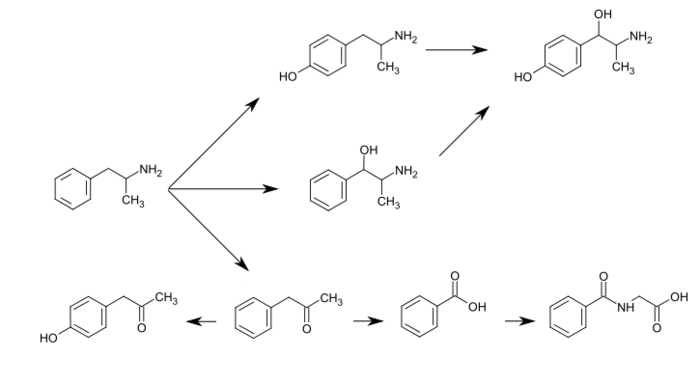4-Hydroxyphenylacetone
 | |
| Names | |
|---|---|
| IUPAC name
1-(4-Hydroxyphenyl)propan-2-one | |
| Other names
p-Hydroxyphenylacetone; para-Hydroxyphenylacetone | |
| Identifiers | |
| 770-39-8 | |
| ChemSpider | 5382241 |
| |
| Jmol-3D images | Image |
| PubChem | 7019274 |
| |
| Properties | |
| Molecular formula |
C9H10O2 |
| Molar mass | 150.17 g·mol−1 |
| Except where noted otherwise, data is given for materials in their standard state (at 25 °C (77 °F), 100 kPa) | |
| Infobox references | |
4-Hydroxyphenylacetone is the parahydroxy analog of phenylacetone, an inactive metabolite of amphetamine in humans.[1][2] When it occurs as a metabolite of amphetamine, it is produced directly from the inactive metabolite phenylacetone.[1][3]
Metabolic pathways of amphetamine
In humans, 4-hydroxyphenylacetone occurs as a metabolite of amphetamine.
References
- ↑ 1.0 1.1 Santagati NA, Ferrara G, Marrazzo A, Ronsisvalle G (September 2002). "Simultaneous determination of amphetamine and one of its metabolites by HPLC with electrochemical detection". J. Pharm. Biomed. Anal. 30 (2): 247–55. doi:10.1016/S0731-7085(02)00330-8. PMID 12191709.
- ↑ "4-Hydroxyphenylacetone". NCBI. PubChem Compound. Retrieved 25 October 2013.
- ↑ "Adderall XR Prescribing Information" (PDF). Medication Guide. United States Food and Drug Administration. pp. 12–13. Retrieved 7 October 2013.
External links
- 4-hydroxyphenylacetone at the US National Library of Medicine Medical Subject Headings (MeSH)
